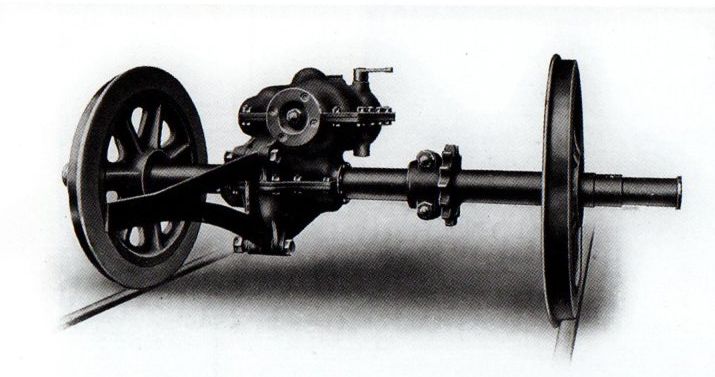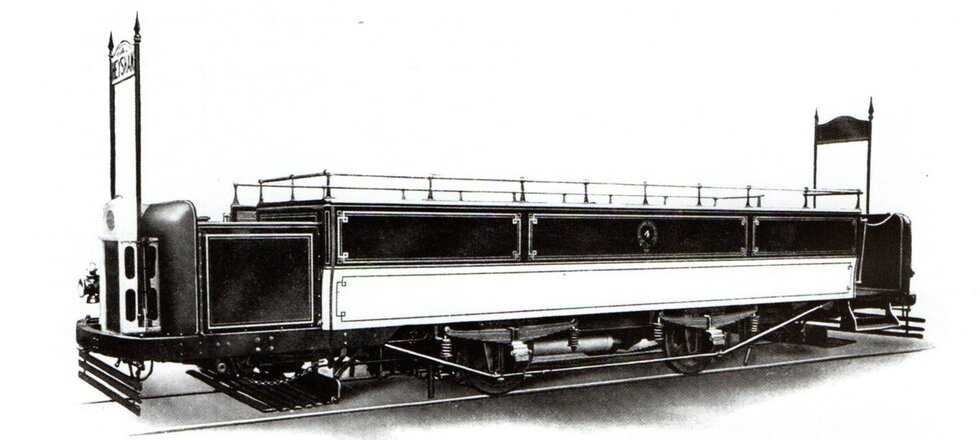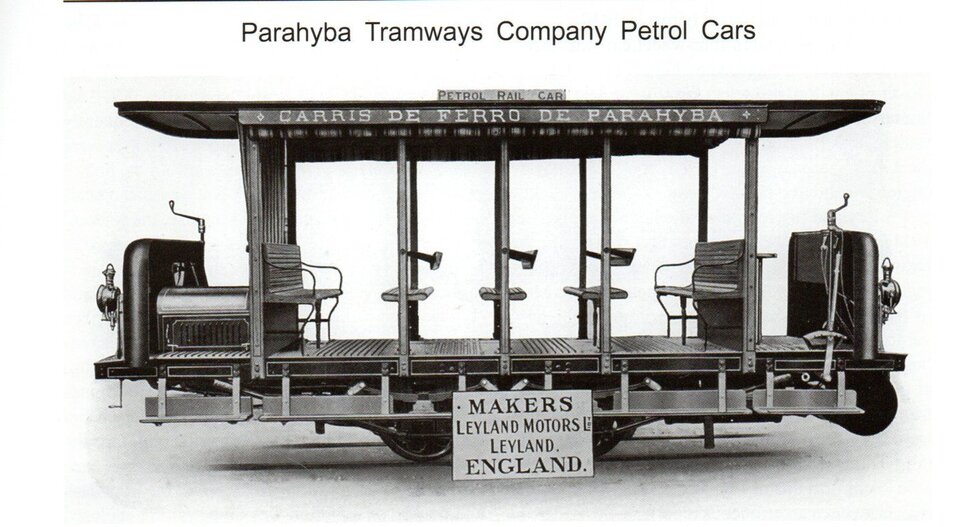24th October 2024 marks 100 years since the closure of one of Britain’s more unusual first-generation tramways, which was operated by the Morecambe Tramway Company in Lancashire. This company-owned system began life as a horse-drawn tramway on 3rd June 1887. Although most of the 4-mile tramway lay within the town of Morecambe, a short sea-front extension of 1½ miles (from the Battery Hotel to Strawberry Gardens), which was wholly within the neighbouring Borough of Heysham, had been constructed in the following year. To complicate matters further, another short section of the line (0.8 miles) had been built by Morecambe Corporation itself just over a decade later, in 1898. However, this was also operated initially by the Tramway Company under a 10-year lease.
Once the lease expired in 1908, the Corporation exercised its right to acquire the entire portion of the tramway that lay within its jurisdiction, together with most of its assets, and continued to operate this as a horse tramway until its closure in 1926. This left Morecambe Tramway Company with the short section of track that lay in Heysham and three of the original fleet of 17 horse cars, without any covered depot accommodation of its own. At first, the Company continued to operate a horse tram service, housing its cars in an old horse omnibus shed that it had acquired. This was positioned adjacent to the original depot that was now owned by the Corporation. Following the Corporation takeover, the Company was well endowed with capital and, in an unusual move, decided to upgrade the original track and replace its horse trams with a fleet of four petrol-driven trams. It was felt that these would be more economical to operate than either the existing horse trams or by electrifying such a short section of track.

Image 1) Line drawing showing elevation and plan of the Morecambe petrol-driven saloon tramcars, as published in Tramway and Railway World, Vol. 31, 8th February 1912, pp. 1-6.
The tramcars themselves were purchased from locally-based Leyland Motors Ltd (formerly The Lancashire Steam Motor Co.). Three closed single-deck tramcars were ordered at a cost of approximately £1,050, the first of which was delivered on 12th December 1911. These were single deck saloon cars seating 36 passengers on garden seats. The bodies and underframes were built by the United Electric Car Company, Preston, and were supplied in a maroon and cream livery with polished mahogany window frames. They were supplied with Leyland 55hp engines of the type fitted to contemporary Leyland fire engines. The engine was placed at one end of the car, with a large water tank at the opposite end supplying coolant to radiators that were located at each end of the tram.

Image 2: A post card depicting Morecambe Tramways Company car No. 1 at the Battery Inn Terminus prior to its departure for Strawberry Gardens, Heysham. Photo: Mike Sutcliffe Collection, published in the Leyland Society Journal Vol. 2, No. 10 (2008), p. 3.
Each tram had a cast iron gear box with 4 forward speeds and reverse. The trams could be driven from either end, the driver sitting to the left-hand side of the front dash/radiator. A specially designed driving axle enabled the tramcar to operate at the same maximum speed regardless of the direction of travel. Petrol consumption was reported to be 8 m.p.g.

Image 3: One of the specially designed Leyland driving axles, probably intended for one of the Morecambe petrol-driven trams. Photo: Mike Sutcliffe Collection, published in the Leyland Society Journal Vol. 2, No. 10 (2008), p. 4.
The newly introduced petrol trams began operating on 15th January 1912. This was the first time petrol-driven tramcars had run on public streets, certainly in Britain. A fourth tramcar – an open railcar locally referred to as a “toast-rack” – was ordered in October 1912 and delivered in January 1913. Although the seating capacity was the same as the saloon cars, this was powered by a smaller Leyland X2.40hp engine.

Image 4: Car No. 4, an open ‘toast-rack’ with central gangway and reversible garden seating. The style of the destination boards (non-reversible on the Morecambe trams) was also used by UECC for later electric toast-racks supplied to Blackpool and Southport. Photo: Mike Sutcliffe Collection, published in the Leyland Society Journal Vol. 2, No. 10 (2008), p. 12.
The service proved popular in the seaside resort, particularly in the summer, when as many as 60 passengers were reported at times on the 36-seater tramcars. In the winter, passenger demand was much lower, as in most other seaside resorts, and the service was delivered by a single saloon car.

Image 5: Demand for rides was heavy during the summer season, as illustrated by this photograph from Mike Sutcliffe’s Collection, published in the Leyland Society Journal Vol. 2, No. 10 (2008), p. 10.
The onset of the First World War with its attendant petrol shortages presented the company with a serious challenge. A solution was eventually found by converting the three saloon cars early in 1918 to run on town gas instead. Being much less dense than liquid petroleum, the gas occupied a much larger volume than the standard petrol tank. To accommodate this, a massive, vulcanised rubber-coated canvas container was fitted to the top of each tramcar, supported by stout wooden sides. The container was filled from the ordinary mains supply at the tram shed. However, due to the volume required, local residents had their gas supply cut off while the refilling process was in operation! Just before the end of the First World War, the government banned the use of gas for transport purposes. Once the conflict was over and petrol supplies had improved, the tramcars were re-converted to run on petrol once more.

Image 6: A rare photograph of a Morecambe Tramways Company petrol tram following its conversion to operate on town gas. It shows the large structure to support the gas bag mounted on the roof and the gas filler pipe projecting from the front of the wooden housing. Photo: Mike Sutcliffe Collection, published in the Leyland Society Journal Vol. 2, No. 10 (2008), front cover.
The ending of the War brought a new and even more threatening challenge to the tramway in the form of an influx of ‘pirate buses’, owned in many cases by small operators who were able to purchase ex-military troop-carrying buses cheaply and set up in competition to the tramway. The tramway responded by purchasing three buses of its own, resulting in a damaging “bus war” during the 1920s. In the longer term, however, it was unable to compete with the steep reduction in fares. This resulted in the closure of the tramway on 24th October 1924. The Tramways Company itself went into voluntary liquidation in February 1926, by which time many of its former shareholders had invested in a new company, The Heysham & District Motors Ltd, which took over the tramway company’s motorbus operations.
As for the tramcars themselves, all but one were broken up at a nearby jetty belonging to a firm of ship-breakers owned by Sheffield-based T. W. (‘Tommy’) Wards. The remaining tramcar body was reported to have gone to nearby Heysham golf club, presumably to serve as a shelter, but its ultimate fate is not known.
Although petrol-driven tramcars didn’t catch on in mainland Britain, Leyland Motors had more success in overseas markets. In 1910 they exported two petrol-driven tramcars to the town of Parahyba do Norte, in the state of Paraiba, Brazil, and supplied the running units for three railcars ordered by Central South African Railways.

Image 7: One of Leyland’s petrol-driven tramcars destined for export to Parahyba in Brazil. Photo: Mike Sutcliffe Collection, published in the Leyland Society Journal Vol. 2, No. 10 (2008), p. 5.
We don’t have any artefacts relating to Morecambe Tramways Company at Crich. However, it is interesting to compare Morecambe’s petrol-driven tramcars with the Museum’s own Barnsley & District Electric Traction Company “Combination Car” Motor Bus No. 5. Of similar vintage, both incorporated bodywork supplied by conventional tramcar manufacturers and both were powered by engines built by Leyland Motors, though with different axles and gearboxes.
The 27-seat Barnsley bus’s 30 hp S3 4-cylinder, 5.2 litre petrol engine was slightly smaller than the 36-seat Morecambe saloon cars’ 55 hp 4-cylinder ‘L’ head engines (probably model U.55/2, according to vintage bus expert Mike Sutcliffe and former owner of the Barnsley bus). Given that the latter were designed to run on rails, they almost certainly weren’t under-powered, which might account for their ability to convey such prodigious loads of holiday-makers.

Image 8: The Barnsley & District Electric Traction Co. No 5 pictured on the day of its hand-over to the Museum, 21st September 2019, which was also the 60th Anniversary of the Tramway Museum Society. Photo: Jim Dignan.
Morecambe’s petrol-powered tramway does feature in a number of the Museum’s books and periodicals. These include Tramway and Railway World, which featured line-drawings of the tramcars together with photographs and a detailed account of the tramway in its February 1912 edition. Another detailed account was published in the Leyland Society Journal Volume 2, No. 10, edited by Mike Sutcliffe, M.B.E., which was published in 2008. The tramway also featured in S. Shuttleworth’s The Lancaster and Morecambe Tramways, Locomotion Papers No. 95, published by Oakwood Press in 1976 and in W.H. Bett and J.C. Gillham’s The Tramways of North Lancashire, edited by J.H. Price, which was published by the Light Rail Association.
With thanks to Museum Volunteer Jim Dignan for producing this article.
Image References:
Image 1) Tramway and Railway World, Vol. 31, 8th February 1912, pp. 1-6.
Image 2: Mike Sutcliffe Collection, published in the Leyland Society Journal Vol. 2, No. 10 (2008), p. 3.
Image 3: Mike Sutcliffe Collection, published in the Leyland Society Journal Vol. 2, No. 10 (2008), p. 4.
Image 4: Mike Sutcliffe Collection, published in the Leyland Society Journal Vol. 2, No. 10 (2008), p. 12.
Image 5: Mike Sutcliffe Collection, published in the Leyland Society Journal Vol. 2, No. 10 (2008), p. 10.
Image 6: Mike Sutcliffe Collection, published in the Leyland Society Journal Vol. 2, No. 10 (2008), front cover.
Image 7: Mike Sutcliffe Collection, published in the Leyland Society Journal Vol. 2, No. 10 (2008), p. 5.
Image 8: Jim Dignan.
